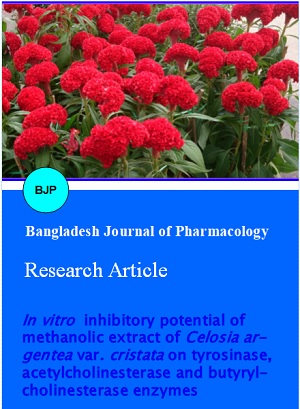In vitro inhibitory potential of methanolic extract of Celosia argentea var. cristata on tyrosinase, acetylcholinesterase and butyrylcholinesterase enzymes
DOI:
https://doi.org/10.3329/bjp.v10i2.22880Keywords:
Acetylcholinesterase, Butyrylcholinesterase, Celosia argentea var. cristata, Neurodegenarative disorders, TyrosinaseAbstract
In the current study, methanol extract of Celosia argentea var. cristata was tested for its inhibitory potential against tyrosinase, acetylcholinesterase and butyrylcholinesterase enzymes at the concentration of 0.5 mM by ELISA microtiter plate assays. A significant tyrosinase inhibitory activity (63.6%), acetylcholinesterase inhibitory activity (80.3%) and butyrylcholinesterse inhibitory activity (68.24%) was shown by crude methanolic extract of C. argentea var. cristata with respective IC50 values of 268.5 ± 0.2 µg/mL, 73.6 ± 0.1 µg/mL and 132.8 ± 0.9 µg/mL. The result of this study reveals the use of C. argentea var. cristata in skin hyperpigmentation, Parkinsons disease and neurodegenerative disorders like Alzheimers disease and dementia.
Downloads
522
393 Read
286

Additional Files
Published
How to Cite
Issue
Section
License
Authors who publish with this journal agree to the following terms:
- Authors retain copyright and grant the journal right of first publication with the work simultaneously licensed under a Creative Commons Attribution License that allows others to share the work with an acknowledgement of the work's authorship and initial publication in this journal.
- Authors are able to enter into separate, additional contractual arrangements for the non-exclusive distribution of the journal's published version of the work (e.g., post it to an institutional repository or publish it in a book), with an acknowledgement of its initial publication in this journal.
- Authors are permitted and encouraged to post their work online (e.g., in institutional repositories or on their website) prior to and during the submission process, as it can lead to productive exchanges, as well as earlier and greater citation of published work (See The Effect of Open Access).
